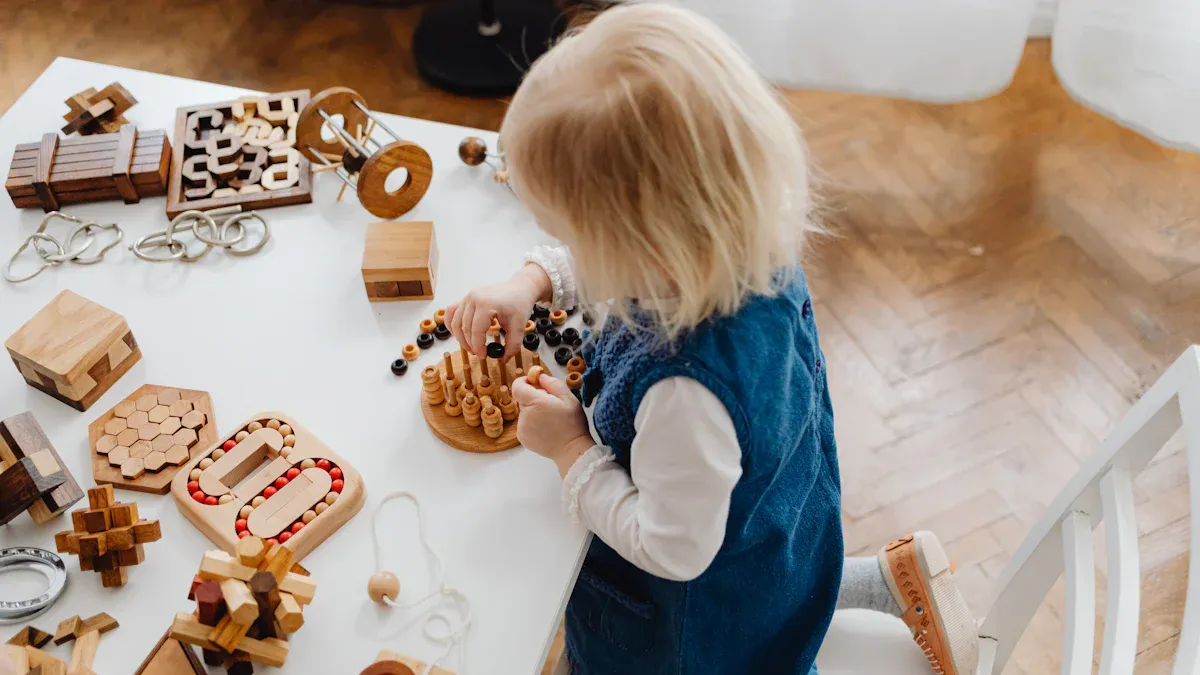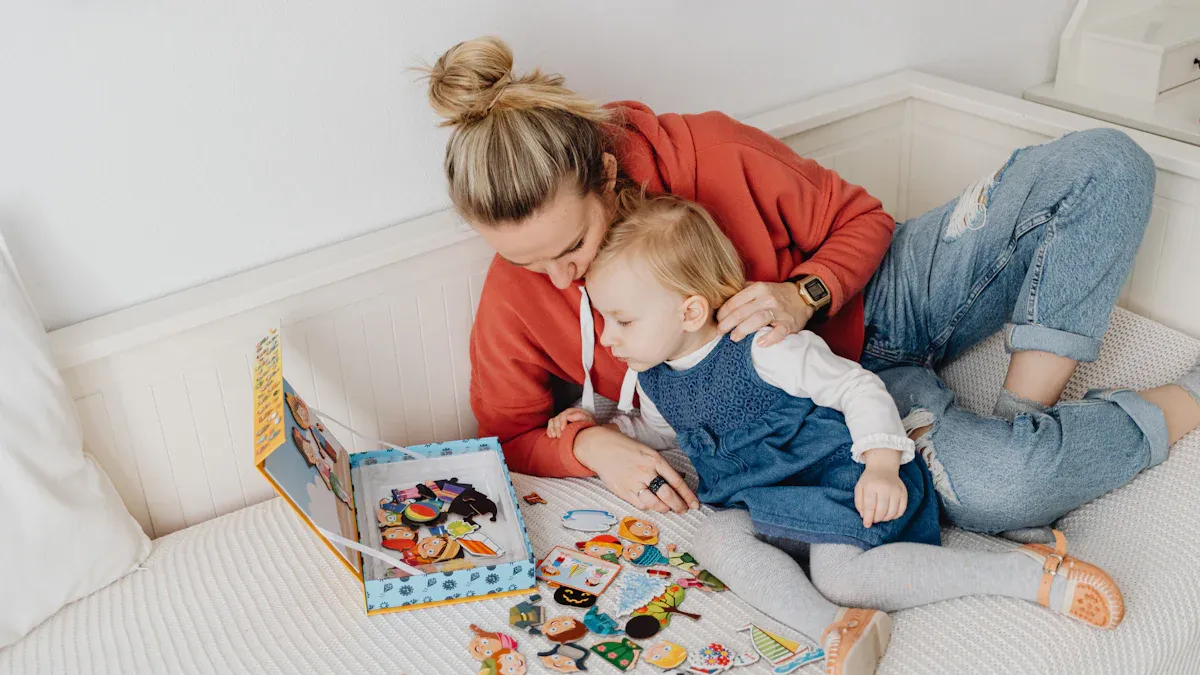You want to make sure busy boards safe for your child to explore and learn. Safety matters most, especially when you choose toys for young children. In the past five years, a Montessori Busy Board 20 in 1 Toy faced a recall. The main reason was a choking hazard from small parts that could separate.
Stay alert for product recalls and always check for updates from experts. Your careful choices help your child play safely and confidently.

Key Takeaways
-
Always pick busy boards with safety labels like EN71, ASTM, or CPSIA. These labels show the toy follows strict safety rules.
-
Check busy boards often for loose pieces or damage. This stops choking risks and keeps your child safe while playing.
-
Choose busy boards that fit your child’s age. Pick simple activities for younger kids. Pick harder tasks for older kids. This makes play safe and fun.
-
Find busy boards made from non-toxic stuff with smooth edges. This lowers the chance of cuts and keeps kids away from bad chemicals.
-
Watch your child when they play. Even safe toys can be risky. Staying nearby helps stop accidents.
Are Busy Boards Safe?

Safety Standards
You want to know if busy boards are safe for your child. Safety rules help you pick the right toy. The U.S. Consumer Product Safety Commission warns about some busy boards. Some, like Kindly Toys and Fasin Busy Board, have small parts that can come off. These small pieces can cause choking. Always look for recalls before you buy or let your child play.
If you choose a certified busy board, check for safety labels like EN71, ASTM, or CPSIA. These labels mean the maker follows strict rules for materials and how the toy is built. Certified busy boards use safe paints and smooth finishes. Rounded edges and strong parts help stop injuries and splinters. You should also make sure beads and buttons do not come off.
Here are features to look for in a certified busy board:
-
Safe, BPA-free plastics and paints without lead
-
Smooth wood with no rough spots
-
Rounded corners and edges
-
Parts that stay attached and do not break off
-
No loose threads or decorations on fabric
Busy boards for young kids use these rules to lower risks. You can compare busy boards and sensory boards in the table below:
|
Safety Consideration |
Busy Boards |
Sensory Boards |
|---|---|---|
|
Small Parts |
Do not use loose pieces for kids under 3 |
Do not use loose pieces for kids under 3 |
|
Edges/Surfaces |
Rounded corners and safe paints |
Rounded corners and safe paints |
|
Supervision |
Watch your child during play |
Watch your child during play |
Not every toy called Montessori or busy board follows these rules. Some use the Montessori name just to sell more but do not follow safety steps. Always pick a certified busy board and read what other parents say.

Choking Hazards
Choking is the biggest worry for parents picking a busy board. You should avoid small parts that can fit in a child’s mouth. For kids under three, all pieces should be bigger than a golf ball.
Parents often worry about:
-
Small parts that can cause choking
-
How strong the materials are
-
No parts that can be removed
You can keep busy boards safe by checking them often. Make sure all parts stay tight. If you see any loose or broken pieces, take the board away until you fix it. Pick boards with big, strong parts. Do not buy boards with beads, buttons, or zippers that come off easily.
When you pick a certified busy board, you help keep your child safe. Makers build these boards to handle rough play. They use strong materials and attach every part well.
Tip: Always watch your child when they play with a busy board. Even safe toys need an adult nearby to stop accidents.
Busy boards that are safe need careful picking and regular checks. Certified busy boards meet higher safety rules, but your care and watching matter most.
Choosing a Safe Busy Board

Materials and Construction
When you choose a busy board, you want to make sure it uses safe materials and strong construction. This helps protect your child from harm and keeps the toy lasting longer. Look for boards made from non-toxic materials. These prevent your child from coming into contact with harmful chemicals. Smooth edges are important because they lower the risk of cuts and splinters, making playtime safer for toddlers.
You should check for these features:
-
Non-toxic paints and finishes
-
Smooth, rounded edges on all surfaces
-
No sharp corners or rough spots
-
Sturdy wood or BPA-free plastic
Certifications can help you know if a busy board meets safety standards. Look for:
-
Compliance with Consumer Product Safety Commission (CPSC) rules
-
Adherence to European Union (EU) safety directives
-
Certifications for non-toxic materials and child safety
Tip: Always check that every part of the busy board is tightly attached. Loose parts can break off and become a choking hazard for toddlers.
You can follow these steps before you buy:
-
Check the materials. Make sure the board uses safe, non-toxic materials like BPA-free plastic or well-sanded wood.
-
Test the durability. Look at how the parts hold up to pulling and twisting. Strong construction means the board will last longer.
-
Inspect attachments. Make sure all pieces are secure. If you find any loose parts, fix them right away.
Manufacturers design busy boards for toddlers with safety in mind. They use sturdy materials and attach items firmly. They avoid small pieces that could come off and cause choking.
Age Appropriateness
You need to pick a busy board that matches your child’s age and skill level. Manufacturers recommend busy boards for children starting at one year old. Some boards have simple activities for younger babies, while others offer more complex tasks for older kids. Children up to age four can enjoy and learn from these toys, depending on their interests.
Here is a table to help you choose the right busy board for your child’s age:
|
Age Range |
Recommended Activities |
|---|---|
|
1-3 years |
Simple activities like turning knobs, opening flaps, and basic fine motor skill tasks. Choose a board with 5-9 elements like doors, gears, abacus, and shape sorters. |
|
3-4 years |
More complex busy boards with activities like lacing, buckles, locks, and keys. Look for busy boards with 10-14 elements. |
|
4-5 years |
Advanced boards with 10+ activities like mini-mazes, stringing beads, gears, locks, and interactive elements. |
You should always follow the manufacturer’s age recommendations. This helps you avoid boards with small parts that are not safe for younger children. For toddlers, pick boards with large, simple pieces that cannot detach easily.
Note: Regularly inspect your busy board for signs of wear. Check for loose parts or damage before each play session. This keeps your child safe and extends the life of the toy.
Choosing the right busy board means looking at both safety and age fit. When you pick a board with safe materials, strong construction, and age-appropriate activities, you give your child a fun and safe way to learn.

Benefits and Risks
Developmental Value
Busy boards help toddlers learn new skills. When you give your child a busy board, they use their hands and fingers. They turn knobs, slide latches, and press buttons. These actions make their fingers stronger. Busy boards also help with hand-eye coordination.
-
Busy boards help kids move their hands in careful ways.
-
They let children practice using their hands and eyes together.
-
The skills from busy boards help with writing and cutting. They also help with things like buttoning shirts.
Busy boards let kids feel different textures and shapes. They see many colors and learn by touching. This helps them focus and solve problems. When your child uses zippers or switches, they learn cause and effect. These activities help their brains grow and teach them how things work.
Note: Busy boards teach kids real-life skills while they play. They let children safely explore objects and become more independent.
Some busy boards say they use Montessori ideas. Real Montessori boards are simple and teach one skill at a time. Boards with too many things can distract kids. They may not follow the true Montessori way.
Supervision Tips
You need to watch your child when they play with busy boards. Always keep an eye on them. Small parts can come off and be dangerous. Certified busy boards for kids one year and older follow safety rules. But you should still check them often.
-
Let your child play alone, but stay close.
-
Watch as your child tries new things.
-
Check the board before play for loose or broken pieces.
Stores say busy boards are not safe for kids under three. Small parts can cause choking. Thin packaging can also be dangerous. Pick boards made for your child’s age. Make sure all parts are attached tightly.
Tip: Watching your child helps them learn and stay safe. You can let them play on their own, but stay alert to stop accidents.
Some busy boards are too busy or have too many activities. These do not match Montessori ideas. The best boards are simple, safe, and teach one skill at a time.
You can make busy boards safe by doing a few things. Pick boards that fit your child’s age and follow safety rules. The table below shows what you should check:
|
Key Consideration |
Details |
|---|---|
|
Size and Choking Hazards |
Choose big, strong parts to stop choking or swallowing. |
|
Safety Standards |
Find boards with CPSC rules and skip ones with small, loose pieces. |
|
Secure Attachments |
Make sure every part stays tight while your child plays. |
|
Age Appropriateness |
Pick activities that match your child’s age for safe fun. |
Watch for recalls by signing up your products and looking for updates. Always watch your child and check the board often for problems. These steps help your child play safely and learn new things. Busy boards are safe and helpful if you follow these tips.

FAQ
Are busy boards safe for babies under 1 year old?
You should not use busy boards for babies under 1 year old. Most boards have small parts or features that can pose a choking risk. Always follow the age recommendation from the manufacturer.
How often should I check my child’s busy board for safety?
You should inspect the busy board before each play session. Look for loose parts, sharp edges, or broken pieces. Regular checks help you catch problems early and keep your child safe.
Can I make my own busy board at home?
Yes, you can make a busy board at home. Use non-toxic materials and large, secure parts. Avoid small items that could come off. Always sand rough edges. Test every part to make sure it stays attached.
What should I do if a part comes loose during play?
Remove the busy board right away. Fix or replace the loose part before letting your child play again. Never let your child use a board with broken or missing pieces.
Do all busy boards follow Montessori principles?
No, not all busy boards follow Montessori principles. True Montessori boards focus on one skill at a time and use simple designs. Many boards use the Montessori name for marketing but do not match the method.









